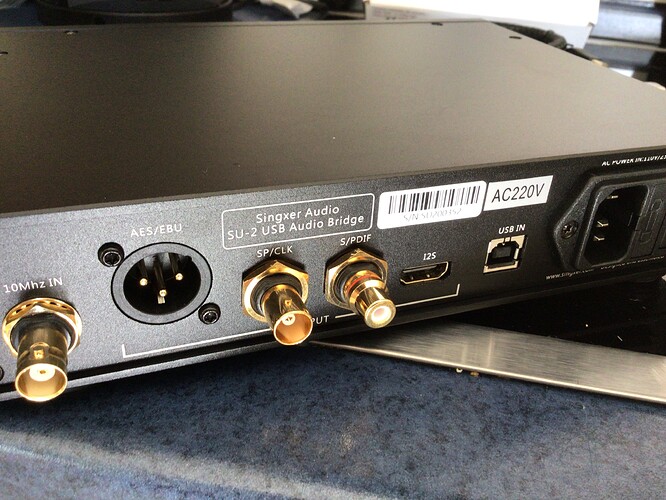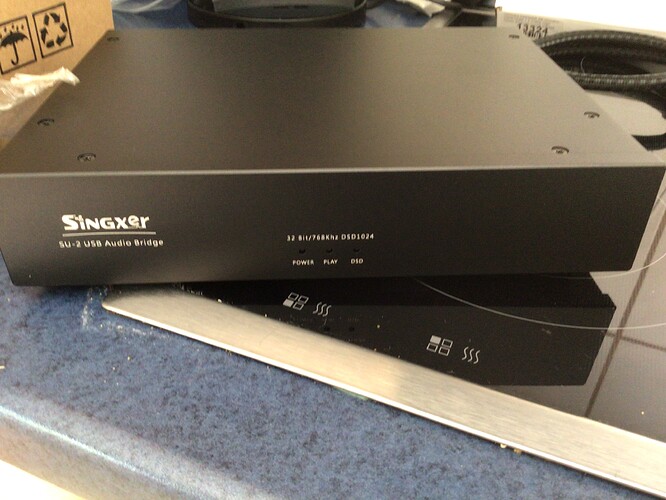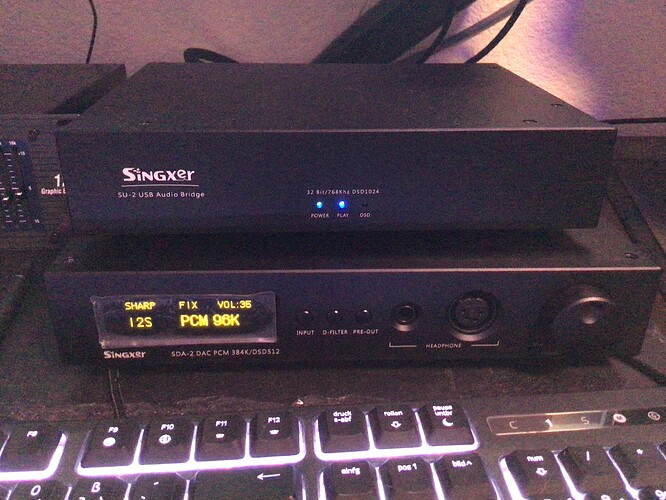Hello,
Here we are again at the small rewiev of the famous Singxer SU 2 that is always doing the rounds in the scene.
Mainly because of its i2S option and jitter reduction.
Reason for purchase:
Since I’ve had the Singxer Sda 2 C for a long time, I’ve always been itching for the I2S output.
Again, a bit more performance and so on. Of course, also the curiosity of the not too well known/spoiled I2S output.
To describe Singxer in a few Words:
What does Singxer do? And what is Singxer?
Singxer, like Matrix Audio, has moved to a digital-only platform to play music in the digital realm.
And they perhaps distinguish themselves from wanting to become mainstream.
Their products offer a very reasonable quality that remains at an affordable level, and also have quite a fine nose for making music sound good.
If I had to rate my Matrix Audio Ipro Mini 2 purely as a headphone section.
I have to say it sounds too cold and doesn’t pick me up, even when I connect another amp.
This is totally different with the Singxer in the headphone section.it picks me up,sounds musical to me.warm,powerful,the heart is there.
On the stereo system, the Marix Audio Dac is definitely the measure of all things in my home and I haven’t heard anything better yet.
So it’s the other way round and I love the Matrix audio.
And I’ve stuck with the Sda 2 C in the meantime and don’t want anything else.
No matter how great the latest Dac is, it leaves me cold.
The Sda 2 C was exactly what I was looking for after 2 years of “searching”. I love it somewhere and after 9 months I still have a lot of fun with it.
I still have a lot of fun with it.
Now for the “upgrade” SU 2 from Singxer.
What can I say? As with the SDA 2 C, there is nothing to say about the manufacturing.
Everything is firmly sorted in its place and at a level you can only dream of.
I can’t find anything wrong with it.
As a tip I can only say and give, check the fuse of the device.
Replace it if necessary.
I have personally used the Hifi Tuning supreme 3, the golden one, in the SDA 2 and have also tried the silver one, but I liked the golden one better.
But it’s not necessarily a must.
The performance was moderate but audible and quickly forgotten.
Connection:
I used the Pangea cable for the Hdmi, the Inakustik Usb cable for the Usb cable and a simple, affordable shielded cable for the power connection.
The fuse has remained original, the current driver has been downloaded from the Singxer homepage.
The information comes directly from Singxer itself for use with the SDA 2.
Su 2 : SW3/6/7 is ON, others are OFF
With the SDA 2, if you have it, SW3/5/6/8 is ON, others are OFF.
I am writing this down because I have not found a single review on how to set what on the Su 2.
The Singxer Su 2 is set to allow the external clock to work, if I understand correctly.
Setup:
Source: Pc connected to Matrix Audio Element H Usb card to Su 2,power supply used separately for the Element H.
Software: Audirvana 32Bit/96 Khz
Hardware: Singxer SDA 2 C, DBX 1215 Eq and Feliks Euforia Tubeamp.Headphones: Audeze Lcd 2 C due to its superb unsparing resolution.
I will make two different statements in advance between the two amps.
Because I noticed two three things.
Burn in:
After plugging it in, I didn’t notice anything directly explosive.
The main reason I blame is my Matrix Audio Element H card…
The card is almost worth it if you only connect one dac/amp.
After a few hours of running and sitting down with the I2S connection, passages shimmer through where you think oh wow.
That’s why I give it 20-30 hours of play-in time, just like the Sda 2, to get it out of my head and eliminate it.
First sound impression:
Nothing that blew me away at first.
While listening and thinking, I thought I’d unplug the headphones from the Feliks Euforia and connect them directly to the Sda 2.
What can I say about the Feliks, my first assumption was correct that it was still masking despite the fact that an Eq is connected.
I still blame the tubes or it is really due to my Eq setting which goes from the SDA2 to the Eq and then to the Feliks.
I’ll explain what I suspect in a moment.
Directly connected to the SDA2 there is definitely a bit more pressure, more depth, a bit more separation, it feels fun.
I will do another A/B test with Su 2 and without.
Back to the Feliks:
Since the connection from the PC to the Dac or Su 2 can be considered clean, even with I2S, the Eq probably needs to be readjusted because the music playback has become even more
more precise and therefore masked.
Or also that the “actual clean signal” is transported to the dirty signal starting with the Eq up to the Feliks. Or the signal chain is too long so that something is lost.
Even if the cables are relatively short, I don’t use cables with a maximum length of 1 metre.
On Saturday I got new driver tubes that are still burning in.
It is possible that this is also the reason.
In the meantime I have made an A/B test between both Singxer devices.Once with Su 2 once without. And the play-in time is also over from Su 2.
Without Su2 Sda 2C connected via Usb:
The bass is a little more powerful, but does not reach all the way to the back. Mids and highs are normal.The shining is there and warm.
The resolution and attacks are there. The description of how the Sda 2 C was rated are trustworthy.
With the Su2 via I2s connection:
The bass is a little less punchy than the Sda 2 but reaches all the way through to the rear and is even more recognisable in place. The mids and highs reach all the way through from the beginning to the rear.
The stage radiates a little more than without the Su2. The localisation is even better with the instruments. I would say it has really become more 3 dimensional than without the Su2.
than without Su2. This is very noticeable with a piano and violin instruments that are present under the mix. (Frontin from Pharell Willams Feat.Jay Z is a very good example of this).
The Su 2 doesn’t really colour anything up and stays musical, it doesn’t play overly exciting or unexciting, I’d say it’s somewhere in between.
Like the Sda 2, it invites us to listen and enjoy music.
The resolution has definitely increased again. When recording live, I’m standing in front of the stage almost live in the scenery.
All in all, the Audeze Lcd 2 has also improved in the hiphop area, although that’s not really its domain. And it’s fun, especially because I always found the bass a bit thin.
Now, with the Su 2, it’s not any more, it’s really crisp and authentic with a good punch.
Su 2 with Feliks Euforia:
As already mentioned, I changed the driver tubes at the weekend.
In order to get everything halfway oneway.
With the Ps Vane tubes I found the sound too neutral. With the Lin lai tubes it changed again.
That’s why it’s a bit difficult to say what has improved where, and it still needs a bit of time.
I disconnected the equalizer completely and used the direct Rca output from the Sda 2 to the Feliks Euforia.
Even though I can switch off the bypass, I wanted to know more about it. I also wanted to create the shortest signal path and minimise the loss through the analogue path.
The signal that actually goes through the Eq then goes to the Euforia.
I found out that it also makes sense to connect the Su 2 to a tube amplifier.
My own impression is that by changing the tubes and adding the Su 2, the bass has increased again compared to the Ps Vane tubes which are relatively neutral.
With the Audeze it was a torture because the bass was relatively bloodless, but not any more, which is why I added the Eq.
Now that the Eq is gone, the sound impressions are similar to those described above with the Su 2 and Sda 2. The separations are a bit better, also more explosive and direct.
But that can also come from different power tubes, which also have an influence on it, I currently have a set of re-labelled Sylvania 6080 in it, which arrived at the same time on Saturday.
But all in all it makes sense I would say.
Technical side:
My impression is that the Su 2 only makes sense when the output device is connected directly.
For example, I2S out to I2S in, coax out to coax in to the stereo system, where the effect is certainly clearest and makes the most sense.
What is not advantageous is if the output of the Su2 is used to the Dac and then looped to another source device or through an Eq as was the case with me or something similar.
And then it goes to the amplifier.
My recommendation would be to use the outputs on the Su2 directly. It is important to set the jumpers on the underside of the Su2.
But at most use the output of the Su2 as described above to the Dac and at most to the tube amplifier, or stereo system via XLR or RCA.
If you want to use the coax out of the Su 2, I think you have to adjust another jumper.
Is it worth the money?
Yes, if you have the connections that your Dac or stereo amplifier supports, such as I2S, coax, it is worth considering. It also makes sense if you cannot use I2S.
Then use the coax connection or Aes, especially if you want to be flexible.
It would make sense to use it instead of the more expensive Matrix Audio Element H Usb card, which only makes sense with a separate power supply.
The card reduces the jitter and relieves the processor, but it also does a very good job.
As a tip I can give a separate Pci Usb 2-3 card to the Pc to plug and the rest of the Su 2 to make that is more than sufficient.
Since the price of the card has risen, plus a separate power supply, you are well above the price of the Singxer Su 2.
Conclusion: On the whole, the Su 2 is an asset.it was not a bad buy.will I keep it? Hell yes.
I thought when I first heard about I2S and read an impression of ASR that it would be a wash.
Now that I’ve tried it myself, I have a different impression of it.It definitely does something to the sound.It makes it smoother,smoother.Not quite as syrupy as a tube amp.
but it goes in that direction.
One regret I have is that I doubted myself and waited too long.








